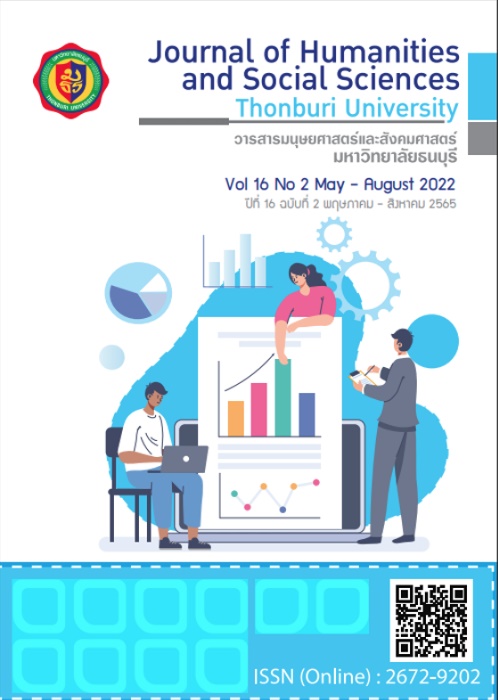ความรักและความนับถือในตราสินค้าต่อการสร้างความภักดีในตราสินค้าของผู้ใช้บริการร้านกาแฟแบรนด์เนม
Main Article Content
บทคัดย่อ
การวิจัยนี้มีวัตถุประสงค์ 1) เพื่อระบุปัจจัยที่ส่งผลต่อความภักดีในตราสินค้าของผู้ใช้บริการร้านกาแฟแบรนด์เนม และ 2) เพื่อเปรียบเทียบความรักในตราสินค้า ความนับถือในตราสินค้าที่ส่งผลต่อความภักดีในตราสินค้าของผู้ใช้บริการร้านกาแฟแบรนด์เนมโดยมีกรอบแนวคิดของงานวิจัยประยุกต์จากแบบจำลองความพึงพอใจของผู้บริโภคแบบอเมริกันและทฤษฎีความรักและความนับถือในตราสินค้ารวบรวมข้อมูลโดยใช้แบบสอบถามที่ได้จากกลุ่มตัวอย่างผู้ใช้บริการร้านกาแฟจำนวน 674 คน วิเคราะห์ข้อมูลด้วยการวิเคราะห์สองตัวแปร และแบบจำลองสมการโครงสร้าง
ผลการวิจัย พบว่า 1) ด้านปัจจัยที่ส่งผลต่อความภักดีต่อตราสินค้าในการใช้บริการร้านกาแฟแบรนด์เนมประกอบด้วย ความนับถือในตราสินค้า ความรักในตราสินค้า ความพึงพอใจ ความไว้วางใจ และข้อแนะนำของผู้บริโภค โดยความนับถือในตราสินค้าส่งผลต่อความภักดีในตราสินค้าสูงกว่าปัจจัยอื่นๆ 2) ด้านความรักในตราสินค้า พบว่า กลุ่มผู้ใช้บริการที่มีอายุระหว่าง 24-41 ปี กลุ่มผู้ใช้บริการที่มีรายได้ 20,000 – 35,000 บาท และกลุ่มที่ใช้บริการมากกว่า 5 ครั้ง/สัปดาห์
มีระดับความรักในตราสินค้าที่ส่งผลต่อความภักดีในตราสินค้าสูงกว่ากลุ่มอื่น ส่วนด้านความนับถือในตราสินค้า พบว่า กลุ่มผู้ใช้บริการที่มีอายุระหว่าง 24-41 ปี กลุ่มผู้ใช้บริการที่มีรายได้ต่ำกว่า 20,000 บาท และกลุ่มที่ใช้บริการน้อยกว่า
2 ครั้ง/สัปดาห์ มีระดับความนับถือในตราสินค้าที่ส่งผลต่อความภักดีในตราสินค้าสูงกว่ากลุ่มอื่น
Article Details

This work is licensed under a Creative Commons Attribution-NonCommercial-NoDerivatives 4.0 International License.
ผลงานที่ปรากฎในวารสารฉบับนี้เป็นลิขสิทธิ์เฉพาะส่วนบุคคลของผู้เขียนซึ่งต้องรับผิดชอบต่อผลทาง กฎหมายที่อาจเกิดขึ้นได้และไม่มีผลต่อกองบรรณาธิการReferences
บุญสม รัศมีโชติ. (2565, พฤษภาคม-สิงหาคม). ความรักและความนับถือในตราสินค้าต่อการสร้างความภักดีในตราสินค้าของผู้ใช้บริการร้านกาแฟแบรนด์เนม. วารสารมนุษยศาสตร์และสังคมศาสตร์ มหาวิทยาลัยธนบุรี. 16(2).
โพสซิชั่นนิ่ง. (2018). เจาะสงคราม “ร้านกาแฟ” ในปั๊มน้ำมัน สู่เชนกาแฟนอกปั๊ม. สืบค้นเมื่อ 25 ธันวาคม 2563, จาก https://positioningmag.com/1180713
มนตรี ศรีวงษ์. (2563). แนวโน้มธุรกิจกาแฟเมืองไทย 2563. สืบค้นเมื่อ 16 เมษายน 2564, จาก http://www.thaismescenter.com
Aaker, D. A. (1991). Managing brand equity: Capitalizing on the value of a brand name. New York: Free Press.
Azize, S., Cemal, Z., & Hakan, K. (2012). Does brand communication increase brand trust? The empirical research on global mobile phone brands. Procedia-Social and Behavioral Sciences. 58: 1361-1369.
Bloemer, J. M. M. and Kasper, H. D. P. (1995). The Complex Relationship between Consumer Satisfaction and Brand Loyalty. Journal of Economic Psychology. 16: 311-329.
Bollen, K. A. (1989). A New Incremental Fit Index for General Structural Equation Models. Sociological Methods & Research. 17(3): 303-316.
Chaudhuri, A., & Holbrook, M. B. (2001). The chain of effects from brand trust and brand affect to brand performance: The role of brand loyalty. Journal of Marketing. 65(2): 81-93.
Chiou, J. S., & Droge, C. (2006). Service quality, trust, specific asset investment, and expertise: Direct and indirect effects in a satisfaction-loyalty framework. Journal of the Academy of Marketing Science. 34(4): 613-627.
Chiu, C. M., Hsu, M. H., Lai, H., & Chang, C. M. (2012). Re-examining the influence of trust on online repeat purchase intention: The moderating role of habit and its antecedents. Decision SupportSystems. 53(4): 835-845.
Comrey, A. L., & Lee, H. B. (1992). Interpretation and application of factor analytic results. Comrey AL, Lee HB. A first course in factor analysis. 2.
Delgado-Ballester, E. (2003). Development and validation of a brand trust scale. International Journal of Market Research. 45(1): 35-54.
Eneizan, A. M. (2018). Factors influencing brand loyalty in durable goods market. International Journal of Academic Research in Business and Social Sciences. 8(1): 326-339.
Euromonitor International. (2018). CAFÉS/BARS IN THAILAND, Retrieved 25 September 2021, from http://fic.nfi. or.th/upload/market_overview/Rep_Cafe_15.01.62.pdf
Fornell, C., et al. (1996). The American customer satisfaction index: nature, purpose, and findings. Journal of marketing. 60(4): 7-18.
Hair, J. F., Black, W. C., Babin, B. J., & Anderson, R. E. (2010). Multivariate data analysis. 7thed. Englewood Cliffs: Prentice Hall.
Haitao, X., & Yanrong, Z. (2020). Research on Consumer Satisfaction Model of Electronic Commerce. Based on BP Neural Network.
Kim, S. H., & Lee, S. A. (2020). The role of marketing communication mix on Korean customers' coffee shop brand evaluations. Journal of Hospitality and Tourism Insights.
Kim, H. W., & Gupta, S. (2009). A comparison of purchase decision calculus between potential and Repeat customers of an online store. Decision Support Systems. 47(4): 477-487.
Kotler, P. (2000). Marketing Management: The Millennium Edition. Person Prentice Hall, Upper Saddle River.
Lau, K. C., & Phau, I. (2007). Extending symbolic brands using their personality: Examining antecedents and implications towards brand image fit and brand dilution. Psychology & marketing. 24(5): 421-444.
Luk, S. T. K., & Yip, L. S. C. (2008). The moderator effect of monetary sales promotion on the Relationship between brand trust and purchase behavior. Journal of Brand Management. 15(6): 452-464.
Oliver, R. L. (1999). Whence consumer loyalty?. Journal of marketing. 63(4_suppl1): 33-44.
Paivio, A. (1969). Mental imagery in associative learning and memory. Phychological review. 76(3): 241.
Roberts, K. (2006). The lovemarks effect: Winning in the consumer revolution. New York: Powerhouse Books.
Roberts, K. (2005). Lovemarks: The future beyond brands. 2nded. New York: Powerhouse Books.
Saleem, H., & Raja, N. S. (2014). The impact of service quality on customer satisfaction, customer loyalty and brand image: Evidence from hotel industry of Pakistan. Middle-East Journal of Scientific Research. 19(5): 706-711.
Santini, F. D. O., Ladeira, W. J., Vieira, V. A., Araujo, C. F., & Sampaio, C. H. (2019). Antecedents and consequences of impulse buying: a meta-analytic study. RAUSP Management Journal. 54(2): 178- 204.
Song, H., Bae, S. Y., & Han, H. (2019). Emotional comprehension of a name-brand coffee shop: focus on lovemarks theory. International Journal of Contemporary Hospitality Management.
Song, H., Wang, J., & Han, H. (2019). Effect of image, satisfaction, trust, love, and respect on loyalty formation for name-brand coffee shops. International Journal of Hospitality Management. 79: 50-59.
Steenkamp, J. B. E., & Geyskens, I. (2006). How country characteristics affect the perceived value of web sites. Journal of marketing. 70(3): 136-150.
Sweeney, J. C., & Soutar, G. N. (2001). Consumer perceived value: The development of a multiple item scale. Journal of retailing. 77(2): 203-220.
Yazdanpanah, M., & Feyzabad, F. R. (2017). Investigating Iranian farmers' satisfaction with agricultural extension programs using the American customer satisfaction index. Journal of Agricultural & Food Information, 18(2): 123-135.
Translated Thai References
Positioning. (2018). Penetrating the war "coffee shop" in the gas station to the coffee chain outside the gas station. Retrieved 25 December 2020, from https://positioningmag.com/1180713 (in Thai)
Ratsameechot, B. (2022, May-August). Brand Love and Brand Respect Affecting Brand Loyalty of Brand-name Coffee Consumers. Journal of Humanities and Social Science. Thonburi University. 16(2). (in Thai)
Sriwong, M. (2020). Coffee business trends in Thailand 2020. Retrieved 16 April 2021, from http://www.thaismes center.com (in Thai)

